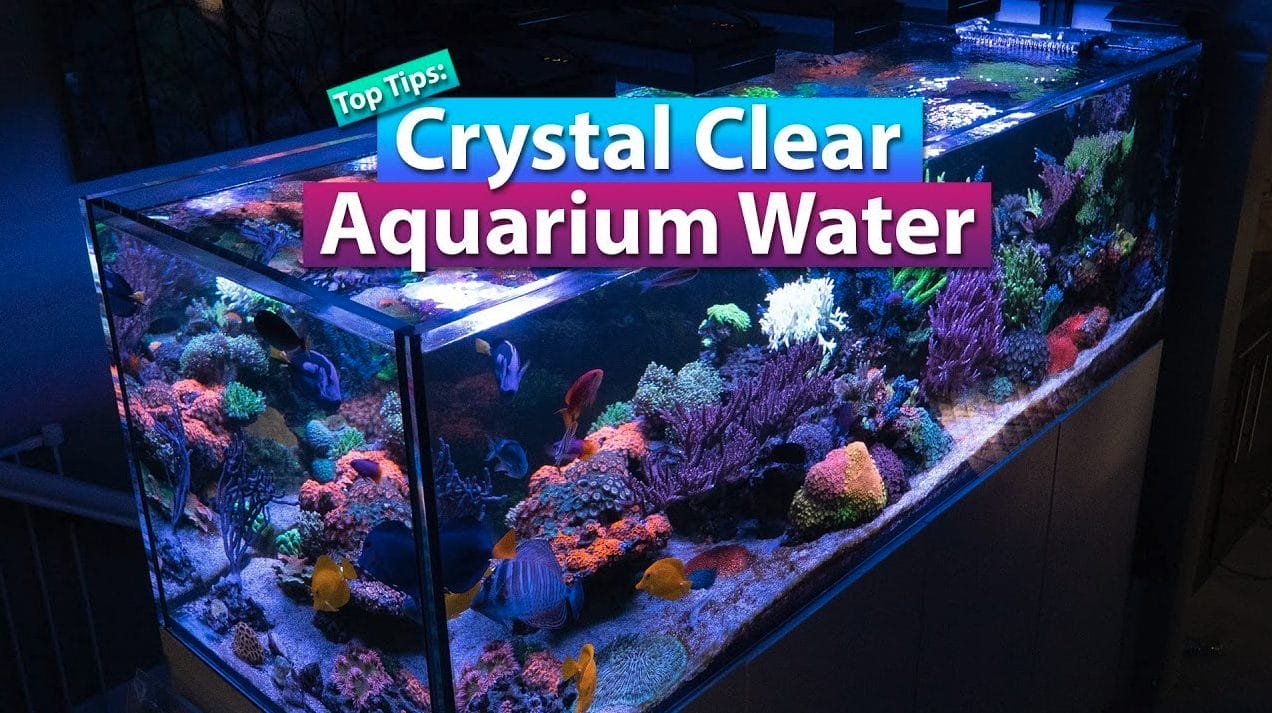
Best Aquarium Water Pumps for Your Tank
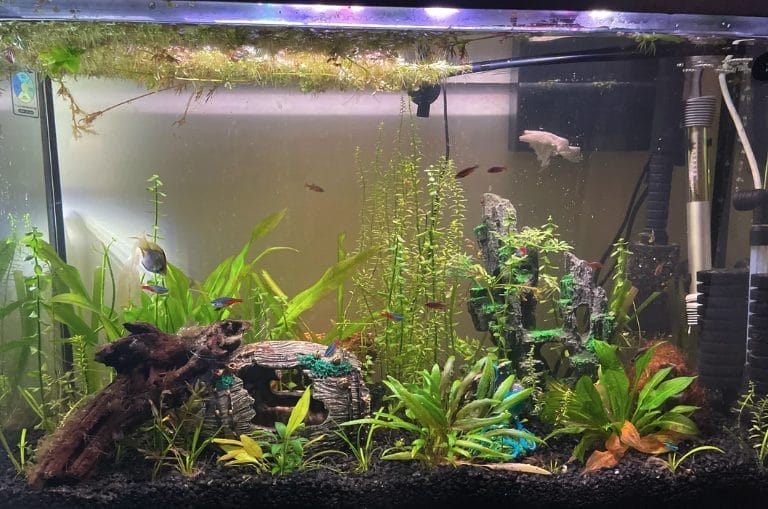
Water pumps are super important for keeping your aquarium full of life and healthy. Think about how we need fresh air to breathe; well, fish and other water critters need moving water to get enough oxygen and stay happy.
While filters in the tank do help move the water around a bit, it’s really the job of a water pump to make sure everything keeps flowing nicely.
With a water pump, you’re making sure that there’s always fresh water moving through your aquarium, which does two big things. First off, it helps mix oxygen into the water so all your aquatic friends can breathe easy.
Secondly, it spreads food and nutrients all over so every part of your tank is getting what it needs. This movement also stops bad stuff like nitrates from building up by making sure they don’t just sit in one spot.
On top of all that practical stuff, having good water flow makes your tank look cooler too! The plants start dancing around in the current created by the pump which adds some extra charm to your underwater world.
So yeah, if you want both a beautiful looking setup and happy marine buddies swimming around without any trouble, constant flow provided by an effective aquarium filter combined with an efficient is pretty much non-negotiable.
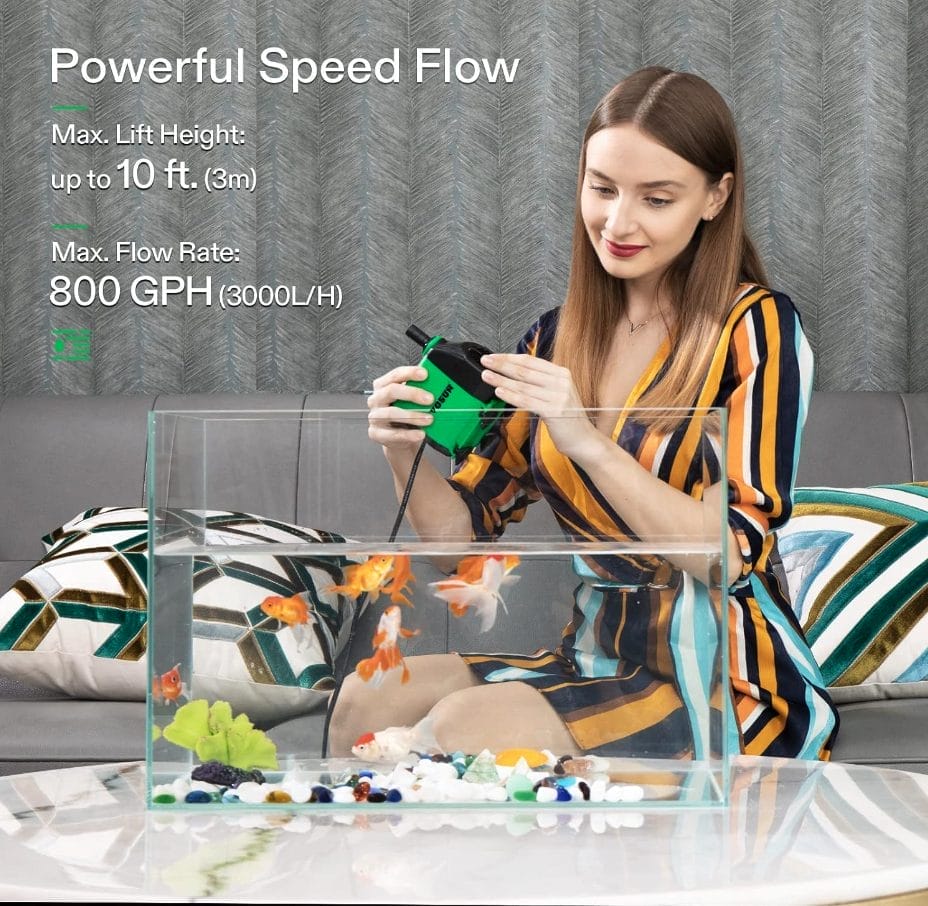
VIVOSUN 800 GPH Submersible Pump
- Specs & Dimensions: 4.33*2.87*3.68 inches
- Max flow rate: 800 GPH (3000L/H); Max lift height: up to 10 ft.; Wattage: 24W; Voltage: 110-120V
- Adjustable Flow Rate
- Detachable & Cleanable
- Many Possible Placement Positions
- Wide Range of Applications
Understanding Aquarium Water Pumps
To really get why aquarium water pumps are so important, we need to start with the basics of how water moves around in a fish tank.
Water flow is all about how the water shifts and stirs inside your tank, and circulation is more about making sure that movement happens everywhere in the system.
Aquarium filters are super important because they clean up the water by getting rid of bits of stuff floating around and harmful chemicals. But just having a filter isn’t enough to keep everything moving as it should.
That’s where water pumps come into play. They team up with filters to make sure food, oxygen, and other good things get spread out evenly in your tank.
By creating a constant flow, these pumps ensure no corner of your aquarium gets left out or becomes a dead zone where junk can pile up.
This keeps the oxygen levels up and cuts down on nitrates which could harm your fish if they got too high. Plus, this whole process stops any spots from becoming still waters where problems might brew.
So basically, by keeping things moving smoothly through every part of an aquarium setup using both filtration systems along with proper circulation via those handy dewatering devices ensures our aquatic friends stay happy & healthy!
The Importance of Water Circulation in Aquariums
Keeping the water moving in an aquarium is super important because it makes sure everything stays healthy under the water. By keeping a constant flow, all the fish and plants get enough oxygen to stay alive and happy.
Oxygen’s a big deal for fish since they need it not just to breathe but also to keep their bodies working right. Without enough movement in the water, there won’t be enough oxygen going around, which can make fish stressed or even cause them to suffocate.
With circulation comes another benefit: getting rid of too many nitrates. Nitrates come from stuff like leftover food and waste breaking down, and if there’s too much of it, that’s bad news for everyone living in the tank. A good swirl of water helps spread these nitrates out so they don’t pile up anywhere harmful.
In short, making sure your aquarium has good circulation isn’t just about keeping things moving; it’s about ensuring your underwater community thrives by maintaining top-notch water quality through proper oxygenation and nitrate distribution.
How Aquarium Water Pumps Enhance Your Tank’s Ecosystem
Water pumps are super important for keeping your aquarium’s environment just right. They make sure everything in the tank, like fish and plants, stays healthy by moving water around.
This movement gets oxygen and food to every corner of the aquarium, which stops any bad stuff from piling up.
For a freshwater aquarium, having this constant flow is key. It keeps the water fresh so there aren’t any spots where waste collects or areas that don’t get enough air. Plus, it keeps the temperature steady and stops harmful chemicals from building up.
Also, when water moves around because of the pump, it makes your tank look more natural and pretty. The way plants move in the current can help fish feel at home since it’s closer to their real-world habitats outside of an aquarium—this means they’re less likely to be stressed out.
So basically, with a good working water pump creating a constant flow in your tank helps keep everyone living there happy while also making things look nice.
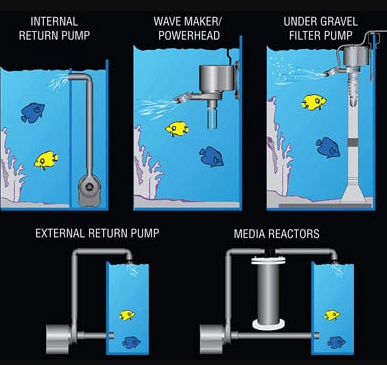
Choosing the Right Aquarium Water Pump
Picking the right water pump for your aquarium is key to keeping a healthy and lively tank, especially if it’s a big one. Here are some things you should think about when choosing a water pump:
- Flow Rate: This tells you how much water the pump can move in an hour, measured in gallons per hour (gph). For bigger tanks, you need a higher flow rate to make sure the water circulates well and there’s enough oxygen. It’s wise to get a pump that can handle at least five times your tank’s volume.
- Efficiency: A good water pump doesn’t just save money; it uses less power too. Aim for pumps with top-notch energy efficiency ratings. These not only cut down on electricity costs but also help protect our planet.
- Noise Level: If your aquarium is in a spot where noise could be bothersome, consider how loud the pump is. Water pumps that go under the water tend to be quieter than those outside because the sound gets muffled by all that H2O! So look out for ones praised for being quiet so everyone stays happy.
- Maximum Flow Rate: Checking out this number gives you an idea of what performance level to expect from your chosen model without any barriers slowing it down—important info ensuring it fits perfectly with what your setup needs.
By focusing on these aspects – flow rate, efficiency levels concerning both cost and energy use as well as operational sounds plus maximum capabilities – selecting an appropriate aquarium water pump becomes simpler whether dealing with larger setups or aiming towards optimal circulation within any given aquatic environment.
Factors to Consider When Selecting a Water Pump
When picking out a water pump for your aquarium, it’s important to think about several things to make sure it works well and keeps your fish happy. Here are the key points:
- Flow Rate: It’s crucial to get a pump that can move enough water for the size of your tank. This helps keep the water moving and full of oxygen.
- Aquarium Size: For bigger tanks, you’ll need a stronger pump to ensure there’s enough water flow throughout.
- Noise Level: If you don’t want a noisy tank, look for pumps that run quietly so they won’t bother you or anyone else around.
- Energy Efficiency: Choosing an energy-saving pump is good for both your wallet and the planet since it uses less power.
- Ease of Maintenance: Go with a pump that’s easy to clean and take care of. Being able to easily reach parts like the impeller means less hassle when doing upkeep.
Keeping these factors in mind will help you find just the right water pump for your aquarium setup.
Comparing Submersible vs. External Water Pumps
When selecting an aquarium water pump, you’ll come across two main types: submersible pumps and external pumps. Here’s a comparison between the two:
Submersible Pumps:
- These pumps are designed to be placed directly in the tank water.
- Easy to install and maintain compared to external pumps.
- Can provide quiet operation as the water absorbs the motor’s sound.
- May rely on the tank water for cooling, which can affect the water temperature.
- Some submersible pumps come with built-in filters to clean the tank water.
External Pumps:
- These pumps are placed outside the aquarium and require additional plumbing.
- Provide higher flow rates and greater pressure compared to submersible pumps.
- Do not dissipate heat back into the tank, making them suitable for temperature-sensitive fish.
- Can be noisier than submersible pumps as there is no water to suppress the motor’s sound.
- External pumps are more suitable for larger aquariums with higher flow rate requirements.
| Submersible Pumps | External Pumps |
| Placed directly in the tank water | Placed outside the aquarium |
| Easy installation and maintenance | Additional plumbing required |
| Quiet operation | Can be noisier compared to submersible pumps |
| Relies on tank water for cooling | Does not dissipate heat into the tank |
| Some come with built-in filters | Higher flow rates and greater pressure |
Consider your specific aquarium setup and requirements to determine whether a submersible or external pump is the best choice for your tank.
Top Recommended Aquarium Water Pumps
When picking the best water pump for your aquarium, there are a bunch of highly suggested ones out there. They’re known for working well and smoothly, giving you a good bang for your buck. Let’s talk about some favorites:
VIVOSUN 800 GPH Submersible Pump
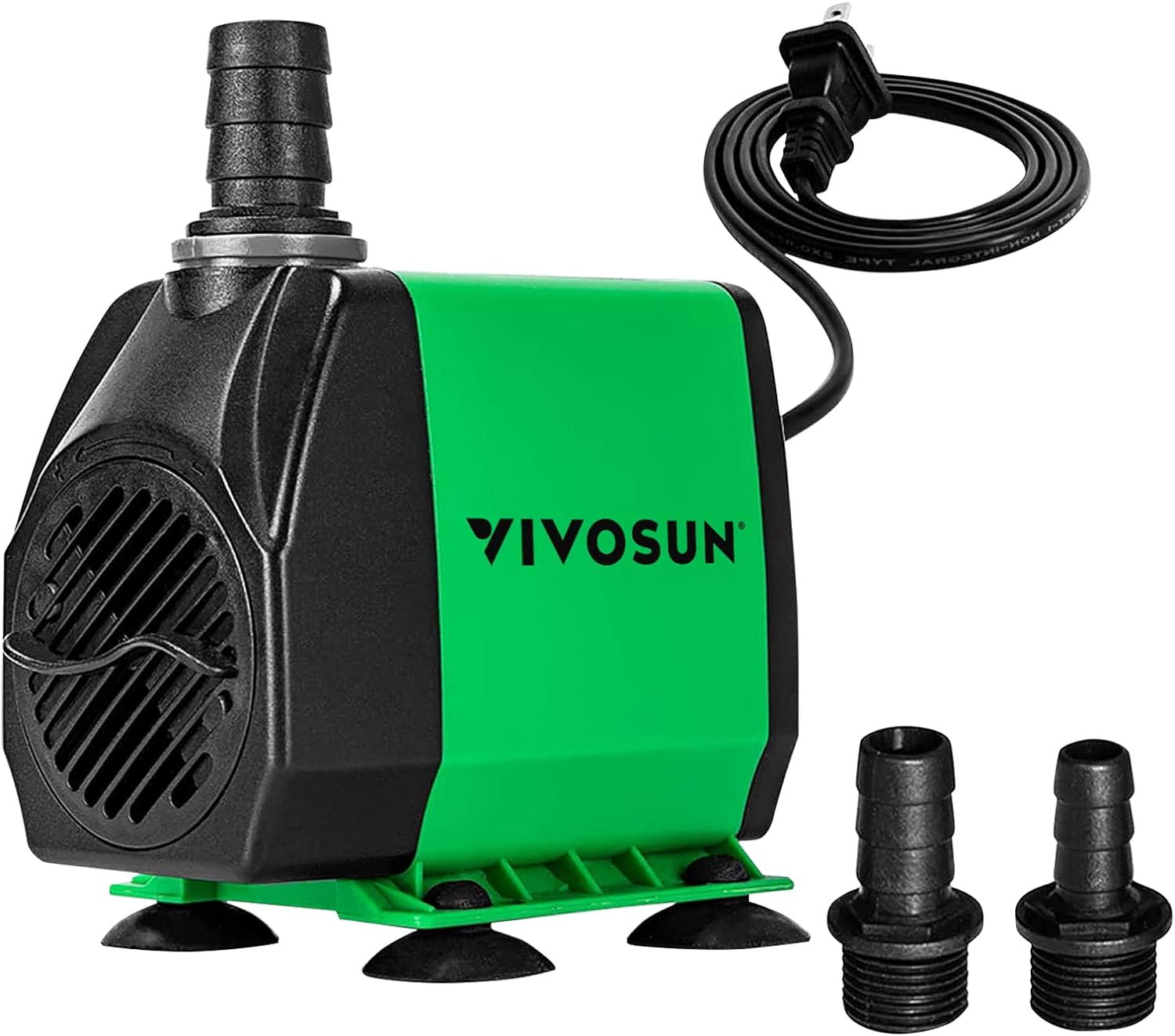
- Specs & Dimensions: 4.33*2.87*3.68 inches
- Max flow rate: 800 GPH (3000L/H); Max lift height: up to 10 ft.; Wattage: 24W; Voltage: 110-120V
- Adjustable Flow Rate
- Detachable & Cleanable
- Many Possible Placement Positions
- Wide Range of Applications
VIVOSUN 800 GPH Submersible Pump Review
VIVOSUN 800 GPH Submersible Pump is from Vivosun is the global leader for at-home growing technology & equipment. With over 10 years of demonstrated excellence in the development and production of growing tools.
Performance
The pump has a maximum flow rate of 800 gallons per hour (3000L/H), which is more than sufficient for my needs. It efficiently circulates water and maintains a good flow, ensuring that fish tank stays clean and well-aerated. The adjustable flow rate is a fantastic feature, allowing me to customize the water pressure according to my specific requirements.
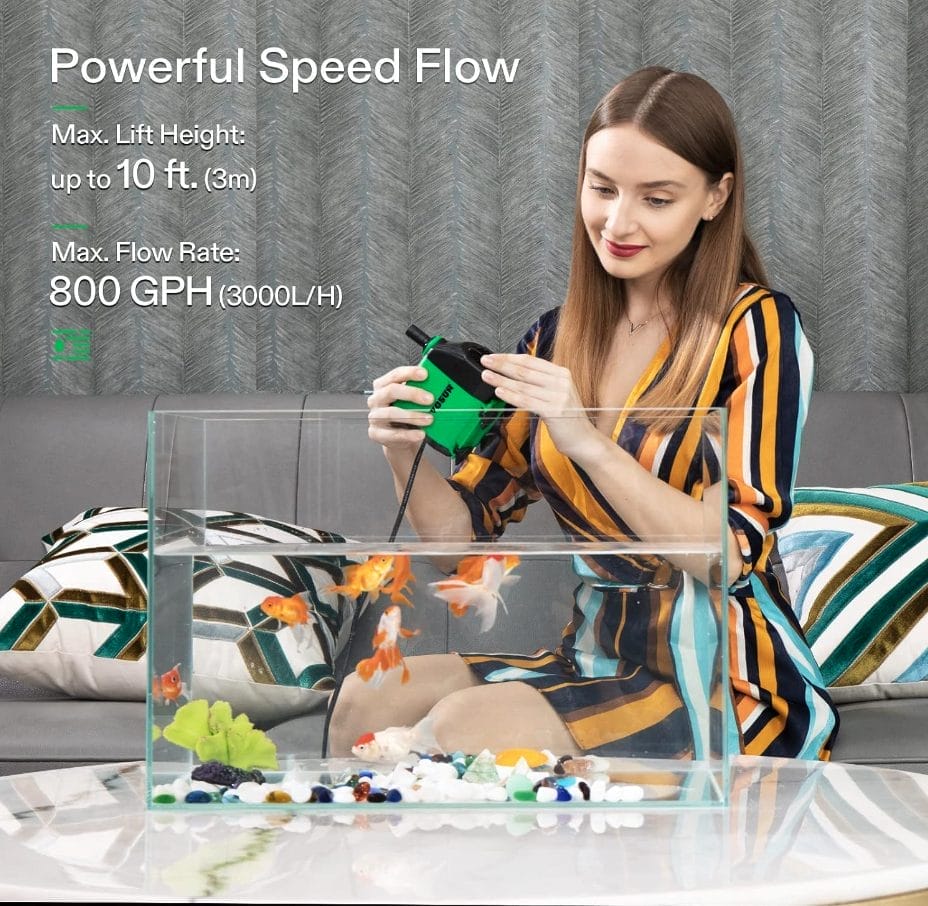
Quiet Operation
One of the standout features of this pump is its ultra-quiet operation. I was pleasantly surprised by how silent it runs, even at full capacity. This is particularly important for me since I have the tank in my living room, and I don’t want any disruptive noise.
Design
The compact design of the pump makes it easy to hide in my aquarium setup. It’s also easy to install and disassemble for cleaning, which is a significant plus. The included three nozzles allow for versatile water flow options, making it suitable for various applications, from fish tanks to garden fountains.
Build Quality
The pump feels sturdy and well-constructed, with a durable plastic body that should hold up well over time. The suction cups provided keep it firmly in place, ensuring it doesn’t move around while operating.
Cord Length
The 65ft power cord is more than adequate, giving me plenty of length to position the pump where I need it without any hassle.
Conclusion
Overall, I highly recommend the VIVOSUN 800GPH Submersible Pump. Its combination of performance, quiet operation, and ease of use makes it an excellent choice for anyone looking to enhance their aquarium or water feature setup. For its price point, it offers great value and functionality.
CWKJ Fountain Pump 400 GPH Submersible
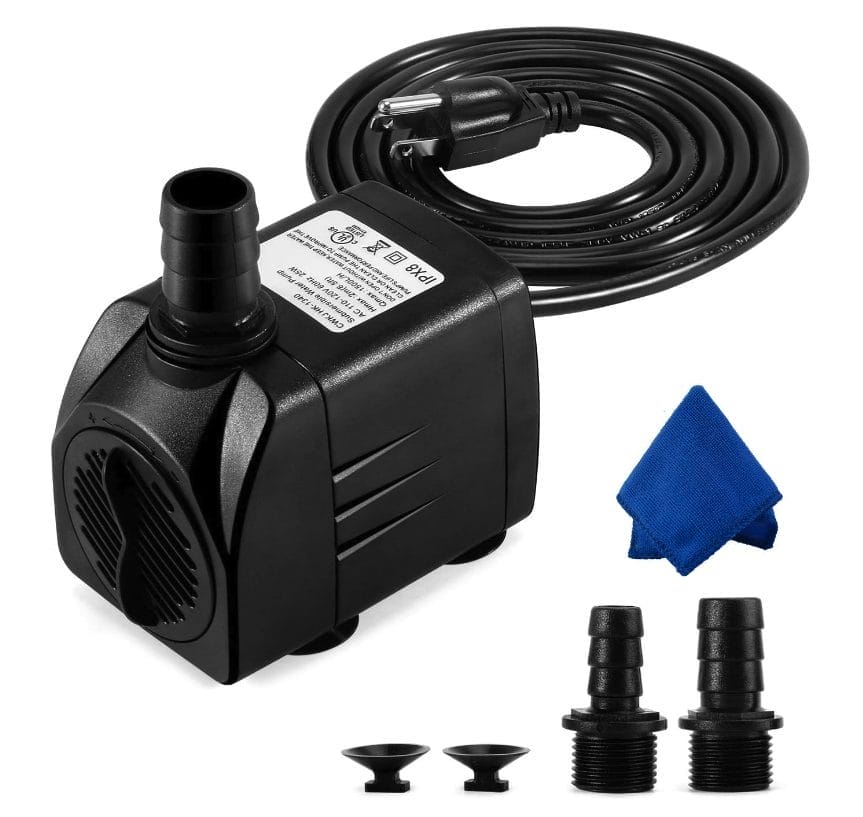
- Comfort & Quite Environment, Voltage : 110 Volts
- Multi-occasions, ideal for a medium-sized aquarium, small pond, water garden, and desktop water fountains.
- Adjustable, designed with an adjusting knob, allowing to get just the amount of water pressure you want.
- Compact but Powerful, easy to hide & disguise, 25W super efficiency motor continually lift water column.
- Easy to use, The fountain pump’s manual disassembly designed shell allow you clean the pump input port and filter/impeller easily.
CWKJ Fountain Pump 400GPH Submersible
The CWKJ Fountain Pump 400GPH Submersible has received positive feedback for its performance and features, making it a popular choice for various water applications.
Performance
This pump boasts a maximum flow rate of 400 gallons per hour, which is suitable for medium-sized fountains. The adjustable water flow feature allows users to customize the output, creating a pleasing water display.
Quiet Operation
Many users appreciate the ultra-quiet operation of this pump. The gentle sound of flowing water contributes to a tranquil atmosphere, enhancing outdoor relaxation spaces.
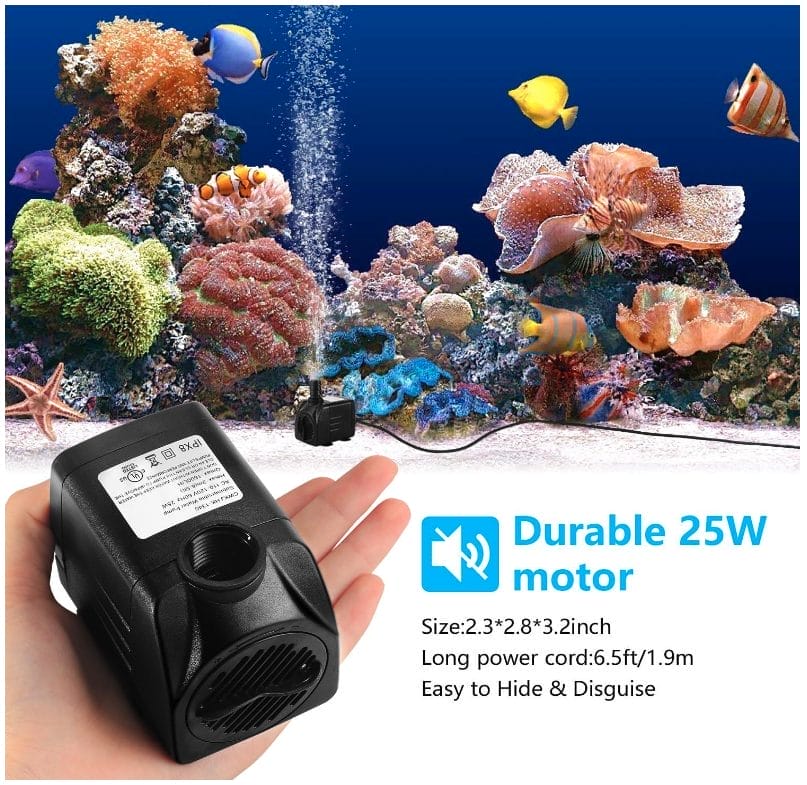
Easy Installation
Installation is straightforward, thanks to the long 65-foot power cord that provides flexibility in placement. The included nozzles allow for different spray patterns, adding versatility to setups.
Build Quality
The CWKJ pump is noted for its durable construction. The sturdy motor has shown reliability over time, while the rubber suction cups securely hold the pump in place, ensuring consistent water flow.
Versatility
This fountain pump is adaptable for various uses, including aquariums and hydroponic systems. Its versatility makes it a valuable option for enhancing both indoor and outdoor water features.
Conclusion
Overall, the CWKJ Fountain Pump is recommended for those seeking a reliable and efficient water pump. Its combination of performance, quiet operation, and ease of use makes it a well-regarded option for improving water features in any setting.
So if you go with one of these recommended pumps and snag yourself a deal without paying for shipping, rest assured knowing your aquarium will be taken care off without spending too much.
Best Submersible Water Pumps for Small to Medium Tanks
If you’ve got a small or medium-sized tank and are looking for an easy way to keep the water moving, submersible water pumps are a great choice. Let’s talk about some top picks for these kinds of tanks :
Superior Pump 91250 Submersible Utility Pump
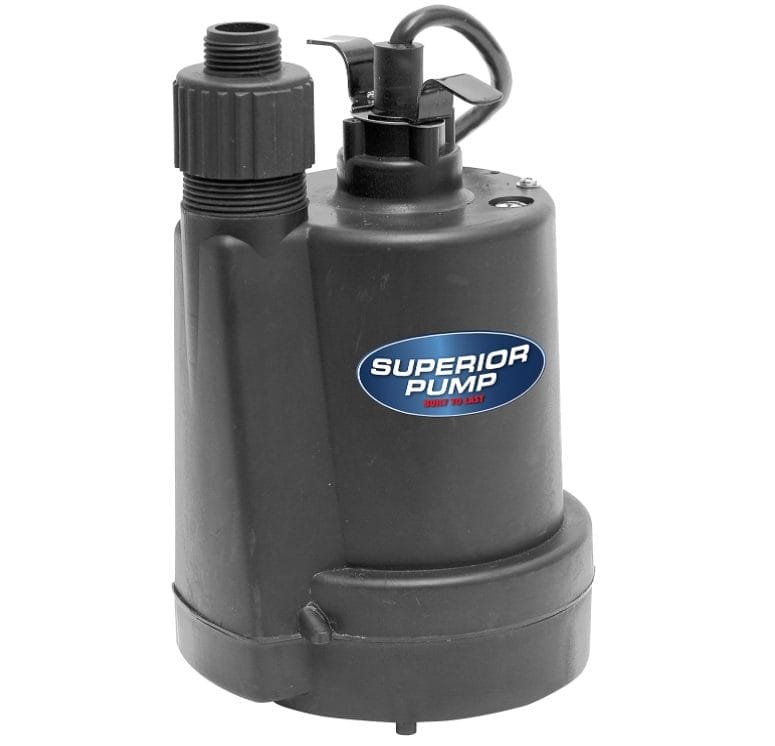
- 1/4 HP Utility pump moves up to 1,800 gallons per hour; pump will lift water up to 25′ of vertical height
- Tough thermoplastic construction; 10′ cord length
- 1-1/4 inch NPT discharge for high capacity pumping; includes 3/4 inch garden hose adapter
- Removable suction screen and handles up to 1/8 inch solids
- Superior Pumps are Built to Last, engineered with quality components and are 100% factory tested
- DISCHARGE SIZE: 1-1/4”.SOLIDS HANDLING:1/8
Superior Pump 91250 Submersible Utility Pump
If you’re in the market for a reliable submersible utility pump, the Superior Pump 91250 is a solid choice. This pump is designed to move up to 1,800 gallons of water per hour, making it perfect for draining pools, basements, or even for garden use.
Performance:
You’ll appreciate how efficiently this pump operates. With a maximum lifting height of 25 feet, it can handle various tasks with ease. Whether you need to remove water from a flooded area or simply transfer water from one location to another, this pump delivers. It’s also equipped to handle solids up to 1/8 inch, which helps prevent clogging and ensures smooth operation.
Build Quality:
Constructed from tough thermoplastic, the Superior Pump 91250 is built to last. The materials are corrosion-resistant, ensuring that it performs well over time, even in challenging conditions. Plus, the 10-foot power cord allows you to reach distant outlets without needing an extension cord.
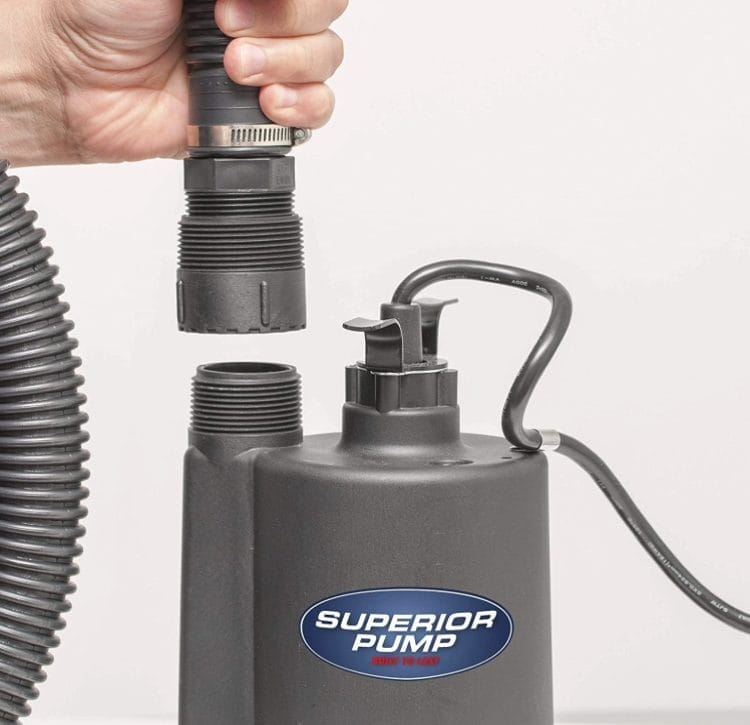
Ease of Use:
Setting up the pump is straightforward. You can connect it to a standard garden hose using the included ¾-inch garden hose adapter. The removable suction screen makes cleaning simple, allowing you to maintain peak performance without hassle.
Noise Level:
One of the standout features is its relatively quiet operation. If you’re using it in a residential area or near your garden, you’ll find it’s not disruptive, which is a significant plus compared to other pumps in the market.
Value for Money:
At an affordable price point, this pump offers excellent value for what you get. Many users have reported satisfaction with its performance relative to the cost, making it a smart investment for homeowners needing a dependable water removal solution.
Overall Impression:
In summary, if you’re looking for an effective and user-friendly utility pump, the Superior Pump 91250 should be on your radar. Its combination of high performance, durable construction, and ease of use make it a reliable option for a variety of applications. You won’t be disappointed with this purchase!
These options are dependable without breaking the bank and do exactly what they need to for smaller aquarium setups by maintaining good circulation.
Installation Guide for Aquarium Water Pumps
Getting your water pump set up right is key to making sure it works well and lasts a long time. Here’s how you can do it step by step:
- Pick the Right Spot: First off, find a good place for your water pump. You’ll want somewhere easy to get to, not too loud, and where the pump can sit steady.
- Get the Plumbing Ready: Next, hook up the inlet and outlet tubes to your water tank using proper fittings and clamps so everything stays tight.
- Attach Tubes: Then connect these tubes from the pump to where they need to go in your aquarium like near filters or back into the tank.
- Make Sure It’s Stable: Check that your pump isn’t going anywhere once placed. If needed, use brackets or something similar for extra hold.
- With everything connected,Test It Out: Before putting it underwater, turn on your water flow rate just enough power through its paces—look out for leaks or weird sounds.
- –Dive Time: If all seems fine during testing ,it’s safe submerge fully ensuring no part of remains above surface which could lead overheating issues
By following these instructions carefully,you’ll have installed properly functioning within setup providing optimal performance throughout
Step-by-Step Installation for Submersible Pumps
Putting a water pump in your fish tank isn’t too hard. Let me walk you through how to do it:
- First off, pick where you want the pump to go in your aquarium. Make sure this spot is easy to get to because you’ll need access for cleaning and upkeep.
- With that done, attach the hose that fits onto the water pump’s outlet. You’ll want to use hose clamps so everything stays tight and secure.
- Next up, put the pump into the water at the spot you chose earlier. It’s important that it’s completely underwater so it doesn’t overheat.
- After placing the pump, take care of routing its hose towards wherever you need it in your tank—like towards a filter or another outlet—and fasten this hose properly with clips or brackets.
- Now comes testing time: plug in and switch on your new setup just to make sure all is working as expected. This might be when you adjust how much water flows through if needed.
- Lastly, don’t forget about keeping things clean! Regularly check and tidy up both pumps and hoses from any dirt build-up which helps keep everything running smoothly.
By following these steps carefully, installing a submersible water pump will help maintain good circulation within an aquarium, ensuring optimal conditions for whatever lives inside by controlling their environment’s flow rate using hoses designed specifically for such setups.
Installing External Water Pumps: What You Need to Know
Putting in a water pump that sits outside your tank or hydroponic setup is a bit more complex than dealing with one that goes inside. Here’s what you need to keep in mind:
- For the plumbing setup, start by figuring out and putting together all the pipes and connections needed for your external pump. This means hooking up the pipes that go into and come out of the pump, making sure they reach where they’re supposed to go around your aquarium.
- With sealing, it’s crucial to pick the right fittings, seals, and clamps so everything fits snugly together without any leaks.
- When it comes to hydroponic systems, make sure your plumbing plan includes all parts necessary for this kind of setup if you’re using an external pump here.
- Picking a spot for your pump involves thinking about how easy it will be to get to, how much noise it might make, and whether it’ll sit steadily where you place it.
- Finally, testing time: Once everything is set up, turn on the pump. Look out for leaks or odd sounds. You might also need to tweak how fast water flows through.
By paying attention these details specific when installing an external water pumps ,you can ensure smooth operation whether its part of fish home or helping plants grow without soil .
Maintenance Tips for Aquarium Water Pumps
Taking good care of your aquarium’s water pump is key to making sure it works well and lasts a long time. Here are some tips you should remember:
- Routine Cleaning: It’s important to clean the pump, its impeller, and housing often. This helps get rid of any dirt or stuff that could block it up. A soft brush or an old toothbrush can reach those tricky spots.
- Check for Leaks: Keep an eye on the pump and where it connects to pipes for any leaks. If you find anything worn out like seals or gaskets, they’ll need replacing.
- Lubrication: Depending on your type of pump, you might need to oil it so everything runs smoothly. The best way to know how is by looking at what the maker suggests.
- Troubleshooting: If something doesn’t seem right with the pump, like if there’s less flow than usual or weird noises, try figuring out what’s wrong yourself first before getting help from others . Look for things blocking its path or parts that have seen better days.
- –Air Stone Maintenance: For pumps hooked up with air stones in order keep them working properly , make sure these air stones stay clean too; sometimes they even need replacement .
By sticking with these maintenance steps and fixing problems as soon as they pop up,you’ll be able extend life span ensure top-notch performance from your aquarium’s water system
Routine Maintenance to Extend Pump Life
To keep your aquarium water pump running smoothly and make it last longer, doing routine checks and cleanings is key. By keeping an eye on it and cleaning out any junk that might block it up, you can make sure it works the best way possible. For a tank with just fish in it, you should give the pump a good clean every 4 to 6 months. But if you’ve got a reef tank, then doing this chore every 2 to 3 months is better.
When cleaning time rolls around, first things first: turn off the power and unplug your water pump. If your pump sits outside of the aquarium (we call these external pumps), go ahead and take off both inlet and outlet tubing pieces connected to it. On the other hand, for those pumps placed inside at sump areas or controlled by some device (controller), pull them out from their spots too.
Next step involves taking apart your water pump carefully—this means removing its outer shell (main housing) as well as pulling out its impeller part which does all the hard work of moving water around in your aquarium or sump area.
Give both these parts—a thorough wash under fresh tap water; use an old toothbrush for scrubbing away stubborn dirt if needed.
In case there’s tough calcium buildup giving you trouble, mix together one-part muriatic acid with three-parts citric acid into a soaking solution where you’ll let those tricky parts sit before rinsing everything really well afterward.
Once all cleaned up, let each piece air dry completely before putting back together again; then reconnect everything including power supply plus any tubing removed earlier during cleanup process.
Troubleshooting Common Water Pump Issues
Even if you take good care of your aquarium, the water pump can still run into some usual troubles. Here’s how to fix them:
- When the flow rate drops: If the water isn’t moving as fast as it should, look for blockages in either the pump or tubing. Getting rid of any dirt or replacing blocked parts will get things back to normal.
- With noise issues: A noisy pump often means something’s loose inside it or there’s stuff stuck that shouldn’t be there. Make sure everything is tight and clean out any junk to stop the racket.
- In case of overheating: If your pump gets too hot, see if anything’s blocking its path and causing trouble. It also helps to check if it’s right for your tank size; maybe add a fan for cooling or move it somewhere less warm.
- Dealing with leaks: Spotting water outside where it shouldn’t be? Go over all connections and seals closely. Tightening up loose spots or swapping out worn-out seals should do the trick.
If these steps don’t clear up your problems, getting in touch with someone who knows their way around a water pump might be best.
Enhancing Aquarium Health with Proper Water Flow
Keeping the water moving in your aquarium is super important for keeping everything healthy and happy. It’s all about making sure there’s enough oxygen, keeping things clean, and ensuring the water quality stays top-notch.
With a good water pump, you can make sure that oxygen gets spread out evenly in the tank. Fish need plenty of oxygen to stay alive; without it, they get stressed out or sick, and might even die. By having a steady flow rate of water thanks to the pump, more oxygen from the air mixes into the water at its surface.
But it’s not just about breathing for fish—constant flow also means cleaner living conditions. Moving water picks up waste bits like uneaten food and harmful chemicals before they settle down or turn toxic. This way, your fishy friends won’t be swimming in anything nasty.
Without proper water flow, spots that don’t see much action could form inside your tank where junk piles up because no one’s cleaning those corners! These are bad news since they can lower oxygen levels big time and let harmful bacteria throw a party.
When thinking about boosting water flow in your aquarium, remember to look at how big your tank is along with what kinds of plants and fish call it home so you pick just right kind of pump speed everyone enjoys—a setup that keeps life undersea lively yet comfy.
The Role of Water Flow in Oxygenation and Filtration
Having a good water flow in your aquarium is super important for keeping the oxygen levels up and making sure everything stays clean. It helps spread oxygen all around, so your fish and plants are happy and healthy.
With enough movement at the top of the tank, it’s easier for fresh oxygen to get into the water while letting carbon dioxide out. This swap is key because it means there’s always plenty of air for your fish to breathe.
By moving water around, you also help keep things tidy by avoiding waste pile-up. As water goes through your filter system, it gets rid of bad stuff like nitrates and ammonia that can make your aquarium a not-so-nice place.
To make sure both oxygenation and cleaning work their best, picking a water pump with just right flow rate matters—a lot depends on how big your tank is along with what kind of fish or plants call it home. Don’t forget to give some TLC to both pump and filtration gear regularly; this way they’ll do their job without any hiccups.
So yeah, boosting water flow isn’t just about making waves—it’s crucial if you want an awesome-looking aquarium where everyone inside thrives.
Creating Natural Water Movement for Fish and Plants
Making your aquarium’s water move like it does in nature is really important for keeping your fish and plants healthy. It’s not just about making things look nice; moving water the way rivers, streams, and oceans do has a lot of good effects.
For fish, having water that moves naturally makes them get some exercise, feel more at home, and stay healthier. Some types of fish like bettas don’t want much movement in their water. On the other hand, tetras and guppies love it when there’s lots of action in the water. By figuring out what each type of fish likes best when it comes to water flow, you can make sure they’re happy.
When we talk about plants in your tank,water flow helps spread food around evenly so all parts get what they need without any extra stuff or algae piling up anywhere. This also means plant roots grow stronger because they’re getting everything they need from moving waters which keeps them away from being weak or sickly due to lack of nutrients or bad conditions.
To set up this kind natural movement with your aquarium, think about where you put your water pump, how big or shaped differently than usual tanks are handled better by certain setups as well as paying attention specifically towards both fishes’ & plants’ needs individually could help too!
Try playing around with different ways the waters flows through until everything seems just right – adjusting things such as the speed (flow rate) might be necessary but once done correctly will ensure a balanced environment for everyone living inside.
Energy Efficiency and Water Pumps
When picking out a water pump for your aquarium, thinking about energy efficiency is key. A pump that’s good at saving energy doesn’t just cut down on how much electricity you use; it also means more money stays in your pocket over time.
Efficient pumps are built to do their job without using up a lot of power. They come with the latest tech in motors and parts that help avoid wasting energy, making them really good at what they do. By choosing one of these, you’re not only spending less on bills but also doing your bit for the planet by keeping your carbon footprint smaller.
To spot an efficient water pump, keep an eye out for ones powered by DC (direct current). These types have gained popularity because they’re better at turning electrical into mechanical power compared to the old-school AC (alternating current) models, which helps lower how much electricity they need.
In searching for the right efficient pump, think about things like how fast it moves water (flow rate), how much power it uses up and what running it will cost you. Some pumps even let you change their speed or set timers so everything works exactly as needed without any waste.
So going with an efficient water setup isn’t just smart—it’s great for both saving cash and building a sustainable home for your aquatic friends without losing out on performance.
Selecting Energy-Efficient Models
Choosing a water pump that’s good for the environment and your aquarium doesn’t have to be hard. Here are some things you should think about to pick one that saves energy:
- Flow rate: It’s important to get a pump with just the right flow rate for your tank size, so it moves water around without using too much power. A pump where you can change how fast or slow it goes is great because then you can adjust it until everything seems just right.
- Power consumption: Look at how much electricity the pump needs to work. Pumps that don’t need as many watts are usually better because they use less energy and cost less money over time.
- Efficiency ratings: Some pumps come with special labels from groups like Energy Star, showing they’re really good at saving energy. Try finding these kinds of pumps since they follow certain rules for being efficient.
- Variable speed control: If a pump lets you change its speed, that means you can set it exactly how your fish tank needs it. This not only cuts down on wasted energy but also makes sure your aquarium has the perfect amount of water movement.
By keeping these points in mind when looking for an eco-friendly water pump, you’ll help protect our planet while making sure your aquarium stays healthy and vibrant.
Tips for Reducing Electricity Use with Water Pumps
To cut down on how much electricity your aquarium water pump uses, here are a few handy tips:
- With a controller: Getting a controller can make it easier to manage how fast and often your water pump runs. This way, you can adjust its work based on what your aquarium needs, which helps save energy.
- By optimizing the flow rate: Make sure the speed at which water moves through your pump matches what’s best for your tank. If it’s too fast, you’re just wasting power. Try out different speeds until you hit the sweet spot for both efficiency and health of your aquarium.
- Through regular maintenance: Keep an eye on keeping that water pump clean and in good shape to keep it running smoothly. A dirty or blocked-up pump has to work harder, using up more energy in the process.
- By considering where to place the pump: Put some thought into where you set up your water pump inside or around your tank so there aren’t any blockages slowing down the flow of water . Doing this means less stress on
- the motor , leading not only better performance but also lower electric bills .
Sticking with these strategies will help bring down those pesky electric costs while ensuring everything in your fishy home stays happy and healthy.
Innovations in Aquarium Water Pump Technology
Lately, there’s been a lot of cool new stuff happening with water pumps for aquariums. These improvements have made the pumps better and easier to use in many ways.
For starters, we now have what you’d call smart pumps. With these, thanks to Wi-Fi and being able to connect them to your smartphone, you can check on and control your pump no matter where you are. They come with apps that let you see everything from how much water they’re moving to how much power they’re using right then and there.
Then there’s something pretty neat for people who have reef aquariums. Some pumps are made just for them, designed so corals grow well by making the water move like it does in real reefs. This means healthier corals without any spots that don’t get enough flow.
On top of all this, the motors inside these pumps got a big upgrade too. They’re not only stronger but also smarter at saving energy which means less money spent on electricity while still keeping things running smoothly in your tank setup.
By keeping up with all these changes in water pump technology, anyone can make their aquarium work better than ever before.
Latest Advances in Water Pump Design
Water pumps for aquariums have gotten some cool upgrades lately, making them work better and fit more easily into your tank setup. Here’s what’s new:
- With variable speed control, you can change how fast the water flows to match what your fish or plants need. This not only gives you more power over the water flow but also helps save on energy.
- Now, there are smart flow modes that copy the way water moves in nature like in rivers or oceans. This is great for keeping your fish and corals happy by giving them a home that feels more natural.
- The motors inside these pumps have gotten an upgrade to brushless DC motors. They’re not just good at saving energy; they also last longer than older types of motors which means less hassle and cost for you.
- Also, these pumps look sleeker and take up less room so they won’t mess with the look of your aquarium setup.
Choosing a pump with these features will make sure it does exactly what you need while making both you and your aquatic friends happier.
Smart Water Pumps: Features and Benefits
Smart water pumps are all about the latest tech. They let you adjust how much water flows and use energy-saving DC controllers to do their job without making a lot of noise, which is perfect for big fish tanks and reef setups.
Some even have smart features that let you check on things and make changes from your phone with an app.
These pumps keep the water moving just right thanks to their top-notch specs and automatic controls. Designed to make life easier, they help keep the water clean, cut down on how much power they use, and work smoothly with other stuff you’ve got in your aquarium.
Conclusion
Picking the right water pump for your aquarium is key to keeping everything inside it healthy and happy. It’s all about understanding how important circulation is and choosing a pump that fits what your tank needs in terms of size and other requirements.
Making sure you take care of your pump through regular upkeep, while also thinking about saving energy, helps make sure it lasts longer and works better for the environment. With new advancements popping up in water pump technology, look out for cool features that match what you want to achieve with your aquarium.
Focusing on getting just the right amount of water flow makes a big difference by helping with oxygen levels, cleaning stuff out through filtration, and making life better for both fish and plants living there.
By putting some thought into buying a good quality water Pump and sticking to best practices when using it,you’re setting yourself up for an aquarium that thrives long-term.
Frequently Asked Questions
How Often Should I Clean My Aquarium Water Pump?
For keeping your aquarium water pump running smoothly, it’s a good idea to clean it every 4 to 6 months if you only have fish in your tank. But with a reef aquarium, cleaning should happen more often—every 2 to 3 months. By doing this regularly, you help keep things clean, make the pump last longer, and keep it working well.
Can I Use a Water Pump for Both Freshwater and Saltwater Aquariums?
Indeed, a lot of water pumps are versatile enough to work for both freshwater and saltwater aquariums. But, it’s crucial to check that the pump fits well with what your specific type of aquarium needs.
What Is the Best Way to Adjust Water Flow Rate?
To get the water flow just right, using a controller for your pump is key. With this gadget, you can tweak how much water your pump pushes out to make sure it’s perfect for your aquarium. It gives you the power to make fine adjustments and control the maximum amount of water flowing through.
Are There Quiet Water Pump Models for Bedroom Aquariums?
When picking out a water pump for your bedroom aquarium, going for one that runs quietly is key so it won’t mess with your sleep. With quiet operation in mind, search for submersible pumps made to work silently, ensuring your bedroom stays a calm place.
How Do I Know If My Water Pump Is Powerful Enough for My Tank?
To figure out whether your water pump is up to the task for your tank, look at how many gallons per hour (gph) it can move. You’ll want a flow rate that’s at least five times more than what your tank holds. This ensures enough movement and circulation for all the living things in there.
Can I Install a Water Pump Myself, or Do I Need Professional Help?
Putting a water pump into your aquarium is something you can do on your own. These pumps usually come with clear instructions, so if you know a bit about plumbing, setting it up should be straightforward. But, for those who might feel uncertain or need some advice, getting help from an expert is always the smart move to make sure everything’s set up right.
